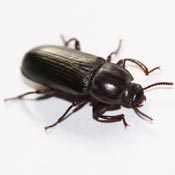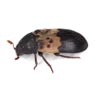Yellow Mealworm beetle

Tenebrio molitor
The yellow mealworm beetle (Tenebrio molitor) is quite a large insect up to 15mm long with even longer larvae. They are commonly for sale as pet and bird food and are widespread throughout the UK. These beetles are usually not present in large numbers and not considered a storage pest. They are associated with birds nests, spilled flour, food and other debris. Mealworm beetles are omnivorous and readily scavenge on carrion. It takes a year for larvae to grow into an adult. Their presence can be indicative of a neglect of hygiene if they are present in significant numbers. Alternatively, the presence of a hidden birds nest or an animal carcass hidden from view might be a breeding source. In addition, other member of the Mealworm beetle family (Tenebrio sp.) include the Dark mealworm beetle (Tenebrio obscurus).
Mealworm beetles and their larvae can occasionally be present in any setting and enter homes irrespective of hygiene standards. However, large numbers are indicative of a hidden food source or poor hygiene standards. Conversely, residual insecticides can drastically reduce an infestation. However, removing the food source should be a priority for complete elimination.
Larder Beetle

Larder beetle
The larder beetle (Dermestes lardarius) is about 8mm long with a distinct beige band across the front of the elytra. In addition, larvae are about 12 mm in length and hairy. Larder beetle larvae feed on animal protein including hides, meat, feathers and bone meal. Larder beetles also scavenge dead birds and debris from old birds nests hidden in lofts. This can be a source of the infestation.
An infestation of Larder beetles is sometimes a sign of poor hygiene. This is especially relevant because they rely on scattered food scraps high in protein and fat. In addition they exibit a habit of tunneling before they pupate and damage into hard structural materials (wood, polystyrene etc.).
Control methods
The best control method is removal of food availability and an improvement of hygiene. For example, a possible source of the infestation might be birds nests in chimneys and voids. Decaying animals and feathers provide an ideal breeding site. Treatment with a residual insecticide to curtail an infestation is the second most appropriate cause of action.
